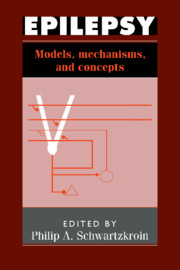Book contents
- Frontmatter
- Contents
- List of contributors
- General introduction
- Section 1 Chronic models in intact animals – concepts and questions
- Introduction
- 1 The kindling model of epilepsy
- 2 Focal trigger zones and pathways of propagation in seizure generation
- 3 Genetic models of the epilepsies
- 4 Noradrenergic modulation of excitability: transplantation approaches to epilepsy research
- 5 Sensitivity of the immature central nervous system to epileptogenic stimuli
- Section 2 Features of the epileptogenic brain
- Section 3 ‘Normal’ brain mechanisms that support epileptiform activities
- Recent advances
- Index
Introduction
from Section 1 - Chronic models in intact animals – concepts and questions
Published online by Cambridge University Press: 03 May 2010
- Frontmatter
- Contents
- List of contributors
- General introduction
- Section 1 Chronic models in intact animals – concepts and questions
- Introduction
- 1 The kindling model of epilepsy
- 2 Focal trigger zones and pathways of propagation in seizure generation
- 3 Genetic models of the epilepsies
- 4 Noradrenergic modulation of excitability: transplantation approaches to epilepsy research
- 5 Sensitivity of the immature central nervous system to epileptogenic stimuli
- Section 2 Features of the epileptogenic brain
- Section 3 ‘Normal’ brain mechanisms that support epileptiform activities
- Recent advances
- Index
Summary
Models of the epilepsies have been developed to address a variety of different issues. Although much of the current focus in epilepsy research is on the cellular and molecular mechanisms underlying abnormal activities of the central nervous system (CNS), the usefulness of such information becomes clear only within a larger context that is provided most valuably by intact-animal models of the epilepsies. Chapters 1 to 5 provide an introduction to some of the issues that can be addressed effectively using intact-animal models. The discussions concerning these models make it clear that we can learn a great deal simply from careful examination of the intact animal – from characterization of behavioral seizures, as well as from electroencephalographic (EEG) phenomenology. These discussions also illustrate a major advantage of studying ‘epilepsy’ in animal models, as opposed to examining the epilepsies directly in human clinical material – the ability to control what appear to be a large number of relevant variables.
Control of the stimuli that initiate the epileptogenic process is a feature of kindling that has made this model perhaps the most widely used of all the current intact animal approaches to studies of the epilepsies. McNamara, one of the leaders in investigation of the kindling model (McNamara et al, 1985), lays out a number of salient features of this model – both technical and conceptual (Chapter 1, this volume).
- Type
- Chapter
- Information
- EpilepsyModels, Mechanisms and Concepts, pp. 20 - 26Publisher: Cambridge University PressPrint publication year: 1993

